Recently I bought this Serving Machine:
In the ad it's called a Ropewalk, but it's for lining/serving a wire.
I just put it together and did a test for my Bluenose. Here's my experience.
When delivered, this box comes with an extra, sturdy cardboard packaging:
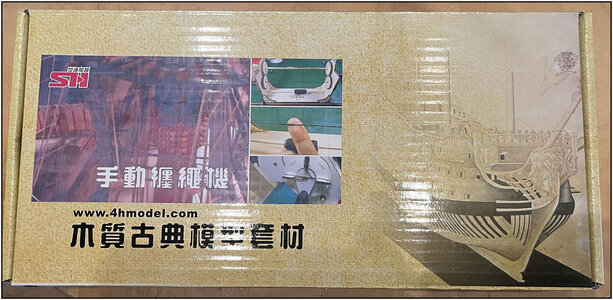
In the box a manual and the packed material:
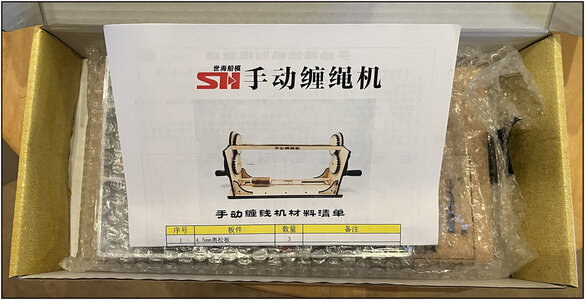
The 4 page manual. The Google Translate app recognizes the Chinese characters and provides useful clues.
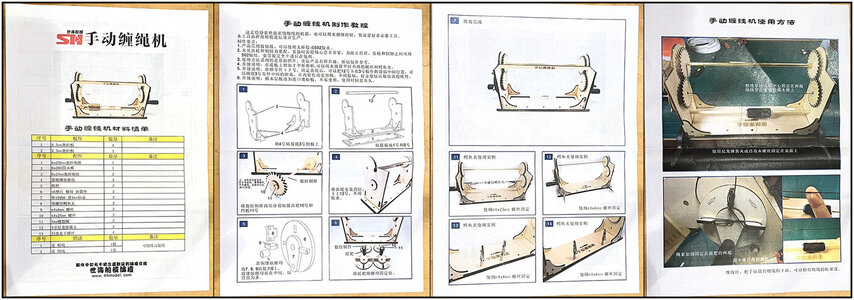
The material wrapped in bubble plastic.
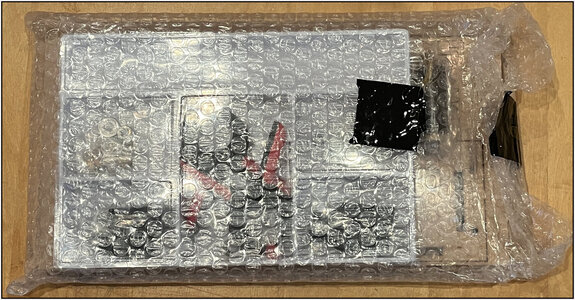
A tray with the metal and plastic materials and the separately packed lasered MDF sheets.
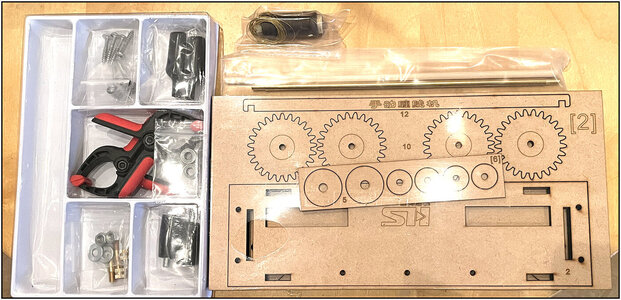
Assembled the frame. I have provided all connections with a drop of glue
On top is already the wooden bracket to keep the sides together. I did that to keep everything in line while the glue was drying. The bracket remains loose and you can place it later when the rollers are in it.
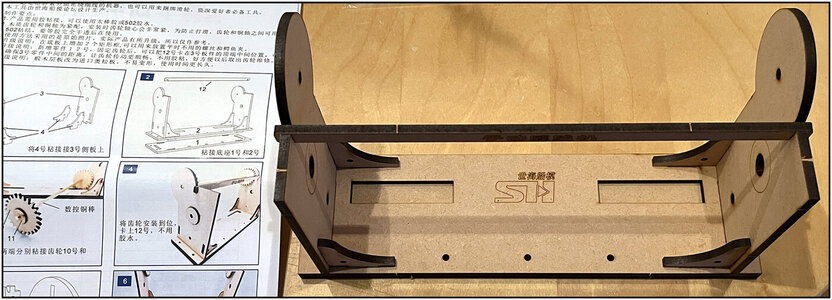
At the top the brass rod with 2 gears has already been placed and the whole is clamped with the bracket.
On the table the parts for driving.
A: Punch these bushings into the openings, where they should be flush with the back of the wood. Otherwise it will clamp too tight after mounting.
B: hammer in these cans up to the flange edge.
Ream the holes for these bushings in the wood with a 5 mm drill bit. Otherwise you will smash the MDF. The holes are actually a little to narrow.
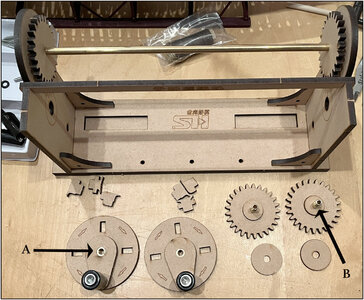
The driving wheels were placed.
The rope to be covered can be attached to the crocodile jaw clips that are provided with screw thread. You can put the screw in question through the bushes. However, the supplied bolts are just too short. Then get your own bolt.
Under the gears a wooden rod that can be slid through well-fitting openings in the side walls. For the spool of thread used for lining.
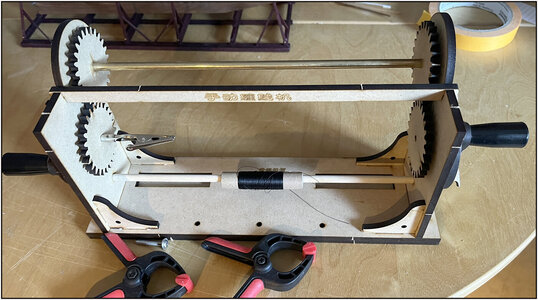
I secured the wire through the bushings in the gears around the cleats on the outside. There is a chance that the crocodile clamps will damage your wire. With the 3 cleats plenty of options.
The direction of rotation is also indicated on the wheels on the outside. This is partly due to the screw thread with which they are attached. Conversely, unscrew them.
If you want to turn the other way, you turn the other gear. I was quite clever.
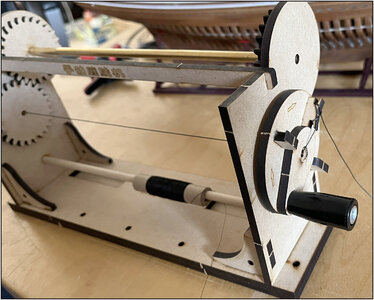
And after some serving I camp the wire now with a small clamp:
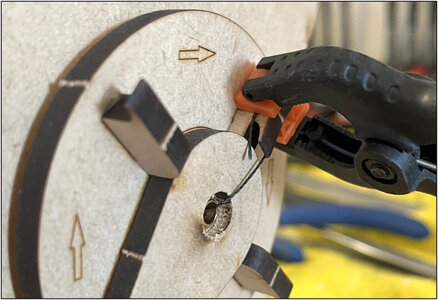
My 1st test. The wire is secured with a clove hitch.
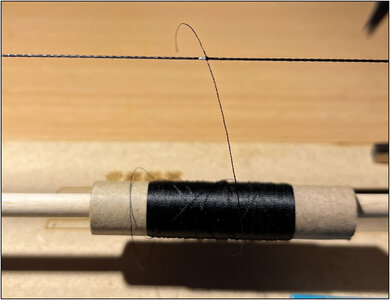
And on the inside a small drop of CA. Start turning immediately and the rest of the glue will be distributed among the next turns. Then don't let go.
First I held the serving thread with my fingers and guided it. Then you should not have hitches, because then you will get openings or doubles.
By trial and error: unwind a piece of wire and keep it in tension with 1 or 2 clothespins.
Due to the tension, the wire hangs at a small angle and makes the adjacent turns by itself. Can you concentrate on spinning the weel.
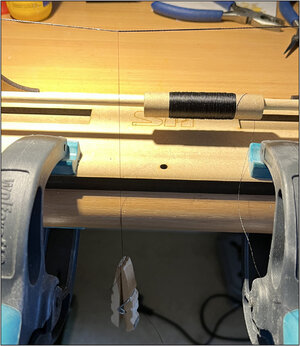
The wire will twist due to the weight of the clothpin. I then pull the supply wire to the clothpin a little towards me. Due to the angle of the wire, the clothpin no longer rotates. With the other hand I run the 'server'.
The result in detail.
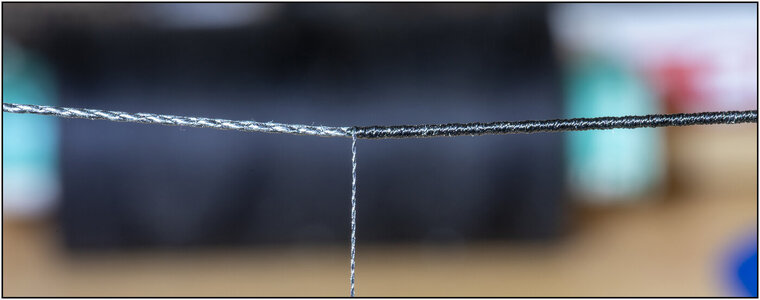
About 4 turns before the end I put a small drop of CA again. That then divides itself among the last turns and does not come loose anymore.
Applied to my Bluenose.
In this example: The main line is 0.45 mm, the serve line 0.12 mm
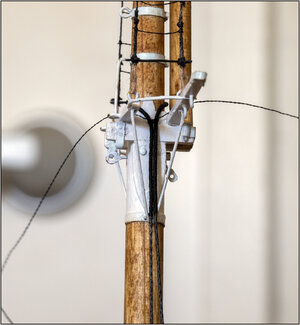
I was pleasantly surprised with the result. And for the amount of 'te be served lines', for me it is useful.
Regards, Peter
In the ad it's called a Ropewalk, but it's for lining/serving a wire.
I just put it together and did a test for my Bluenose. Here's my experience.
When delivered, this box comes with an extra, sturdy cardboard packaging:

In the box a manual and the packed material:

The 4 page manual. The Google Translate app recognizes the Chinese characters and provides useful clues.

The material wrapped in bubble plastic.

A tray with the metal and plastic materials and the separately packed lasered MDF sheets.

Assembled the frame. I have provided all connections with a drop of glue
On top is already the wooden bracket to keep the sides together. I did that to keep everything in line while the glue was drying. The bracket remains loose and you can place it later when the rollers are in it.

At the top the brass rod with 2 gears has already been placed and the whole is clamped with the bracket.
On the table the parts for driving.
A: Punch these bushings into the openings, where they should be flush with the back of the wood. Otherwise it will clamp too tight after mounting.
B: hammer in these cans up to the flange edge.
Ream the holes for these bushings in the wood with a 5 mm drill bit. Otherwise you will smash the MDF. The holes are actually a little to narrow.

The driving wheels were placed.
The rope to be covered can be attached to the crocodile jaw clips that are provided with screw thread. You can put the screw in question through the bushes. However, the supplied bolts are just too short. Then get your own bolt.
Under the gears a wooden rod that can be slid through well-fitting openings in the side walls. For the spool of thread used for lining.

I secured the wire through the bushings in the gears around the cleats on the outside. There is a chance that the crocodile clamps will damage your wire. With the 3 cleats plenty of options.
The direction of rotation is also indicated on the wheels on the outside. This is partly due to the screw thread with which they are attached. Conversely, unscrew them.
If you want to turn the other way, you turn the other gear. I was quite clever.

And after some serving I camp the wire now with a small clamp:

My 1st test. The wire is secured with a clove hitch.

And on the inside a small drop of CA. Start turning immediately and the rest of the glue will be distributed among the next turns. Then don't let go.
First I held the serving thread with my fingers and guided it. Then you should not have hitches, because then you will get openings or doubles.
By trial and error: unwind a piece of wire and keep it in tension with 1 or 2 clothespins.
Due to the tension, the wire hangs at a small angle and makes the adjacent turns by itself. Can you concentrate on spinning the weel.

The wire will twist due to the weight of the clothpin. I then pull the supply wire to the clothpin a little towards me. Due to the angle of the wire, the clothpin no longer rotates. With the other hand I run the 'server'.
The result in detail.

About 4 turns before the end I put a small drop of CA again. That then divides itself among the last turns and does not come loose anymore.
Applied to my Bluenose.
In this example: The main line is 0.45 mm, the serve line 0.12 mm

I was pleasantly surprised with the result. And for the amount of 'te be served lines', for me it is useful.
Regards, Peter
Last edited:







